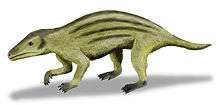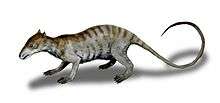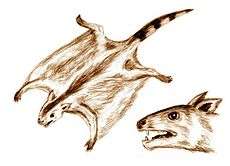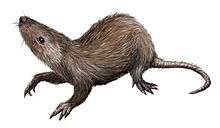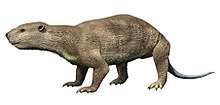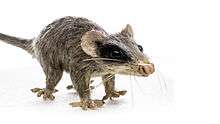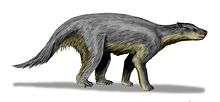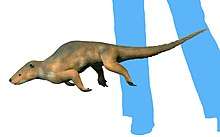Herpetotheriidae
Herpetotheriidae is an extinct family of metatherians. Although sometimes placed in the living opossum family (Didelphidae, as a subfamily Herpetotheriinae), they may form the sister clade to all living marsupials.[1] Species of this family are generally reconstructed as terrestrial.[2] Fossils of herpetotheriids come from North America, Asia, Europe, Africa, and perhaps South America. The oldest representative is Maastrichtidelphys from the latest Cretaceous (Maastrichtian) of the Netherlands[3] and the youngest member is Amphiperatherium from the Middle Miocene of Europe.[4]
| Herpetotheriidae | |
|---|---|
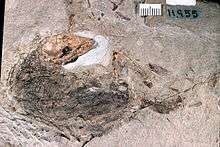 | |
| Herpetotherium | |
| Scientific classification | |
| Kingdom: | Animalia |
| Phylum: | Chordata |
| Class: | Mammalia |
| Clade: | Marsupialiformes |
| Family: | †Herpetotheriidae Trouessart, 1879 |
| Genera | |
|
See text. | |
| Synonyms | |
|
Herpetotheriinae | |
The family includes the following genera:[5]
- Amphiperatherium (Early Eocene to Middle Miocene, Europe; synonyms: Oxygomphius, Microtarsioides, Ceciliolemur)
- Asiadidelphis (Late Eocene to Early Oligocene, Kazakhstan and Pakistan)[6]
- Copedelphys (Late Eocene to Early Oligocene, North America)
- Entomacodon (Middle Eocene, North America; synonym: Centracodon)
- Golerdelphys (Late Paleocene, North America)[7]
- Galatiadelphys (Middle Eocene, Turkey)
- Herpetotherium (Early Eocene to Middle Miocene, North America)
- Maastrichtidelphys (Maastrichtian, Europe)[8]
- Nortedelphys (Lancian, North America)[9]
- Peratherium (Early Eocene to Early Miocene, Europe; Early Oligocene, Africa;[10] synonyms: Alacodon, Qatranitherium)
- Swaindelphys (Early Paleocene, North America)
The following genera have been placed in the family, but their placement is disputed or obsolete:
References
- Asher et al. 2007, p. 318.
- Asher et al. 2007, p. 322.
- Martin 2005, p. 497; Asher 2007, p. 318.
- Mörs, von der Hocht & Wutzler 2000, p. 159.
- McKenna & Bell 1997, pp. 69–70.
- Crochet et al. 2007, pp. 634–635.
- Thomas E. Williamson; Donald L. Lofgren (2014). "Late Paleocene (Tiffanian) metatherians from the Goler Formation, California". Journal of Vertebrate Paleontology 34 (2): 477–482. doi:10.1080/02724634.2013.804413.
- Martin et al. 2005.
- Case, Goin & Woodburne 2005, pp. 473–482.
- Hooker et al. 2008.
- Hooker et al. 2008, p. 635.
- Crochet et al. 2007, p. 635.
- Smith et al. 2007, p. 1008.
- Goin & Candela 2004, p. 18.
Literature cited
- Sánchez-Villagra, M.; Ladevèze, S.; Horovitz, I.; Argot, C.; Hooker, J. J.; MacRini, T. E.; Martin, T.; Moore-Fay, S.; De Muizon, C.; Schmelzle, T.; Asher, R. J. (2007). "Exceptionally preserved North American Paleogene metatherians: Adaptations and discovery of a major gap in the opossum fossil record". Biology Letters. 3 (3): 318–322. doi:10.1098/rsbl.2007.0090. PMC 2390683. PMID 17426007.CS1 maint: ref=harv (link)
- Case, J.A.; Goin, F.J.; Woodburne, M.O. (2005). ""South American" marsupials from the Late Cretaceous of North America and the origin of marsupial cohorts". Journal of Mammalian Evolution. 12 (3–4): 461–494. doi:10.1007/s10914-005-7329-3.CS1 maint: ref=harv (link)
- Crochet, J. -Y.; Antoine, P. -O.; Benammi, M.; Iqbal, N.; Marivaux, L.; Métais, G.; Welcomme, J. -L. (2007). "A herpetotheriid marsupial from the Oligocene of Bugti Hills, Balochistan, Pakistan". Acta Palaeontologica Polonica. 52 (3): 633–637.CS1 maint: ref=harv (link)
- Goin, F. J.; Candela, A. M. (2004). "New Paleogene marsupials from the Amazon Basin of eastern Perú". Science Series, Natural History Museum of Los Angeles County. 40: 15–60.CS1 maint: ref=harv (link)
- Hooker, J.J.; Sánchez-Villagra, M.R.; Goin, F.J.; Simons, E.L.; Attia, Y.; Seiffert, E.R. (2008). "The origin of Afro-Arabian 'didelphimorph' marsupials". Palaeontology. 51 (3): 635–648. doi:10.1111/j.1475-4983.2008.00779.x.CS1 maint: ref=harv (link)
- Martin, J.E.; Case, J.A.; Jagt, J.W.M.; Schulp, A.S.; Mulder, E.W.A. (2005). "A new European marsupial indicates a Late Cretaceous high-latitude Transatlantic dispersal route". Journal of Mammalian Evolution. 12 (3–4): 495–511. doi:10.1007/s10914-005-7330-x.CS1 maint: ref=harv (link)
- McKenna, M. C.; Bell, S. K. (1997). Classification of Mammals: Above the Species Level. Columbia University Press. p. 631. ISBN 978-0-231-11013-6.CS1 maint: ref=harv (link)
- Mörs, T.; Hocht, F.; Wutzler, B. (2000). "Die erste Wirbeltierfauna aus der miozänen Braunkohle der Niederrheinischen Bucht (Ville-Schichten, Tagebau Hambach)". Paläontologische Zeitschrift. 74 (1–2): 145–170. doi:10.1007/BF02987958.CS1 maint: ref=harv (link)
- Smith, T.; Rana, R. S.; Missiaen, P.; Rose, K. D.; Sahni, A.; Singh, H.; Singh, L. (2007). "High bat (Chiroptera) diversity in the Early Eocene of India". Naturwissenschaften. 94 (12): 1003–1009. Bibcode:2007NW.....94.1003S. doi:10.1007/s00114-007-0280-9. PMID 17671774.CS1 maint: ref=harv (link)

